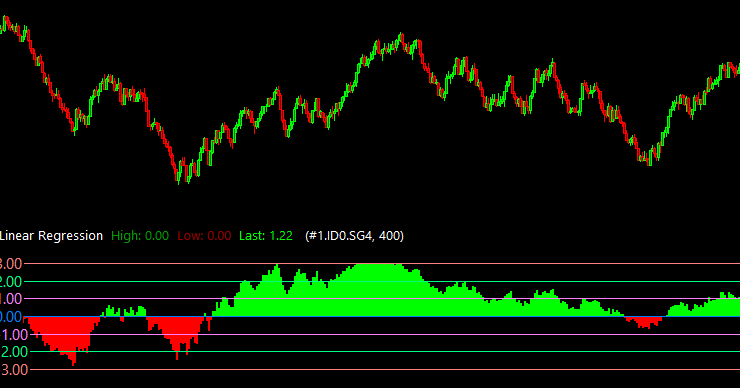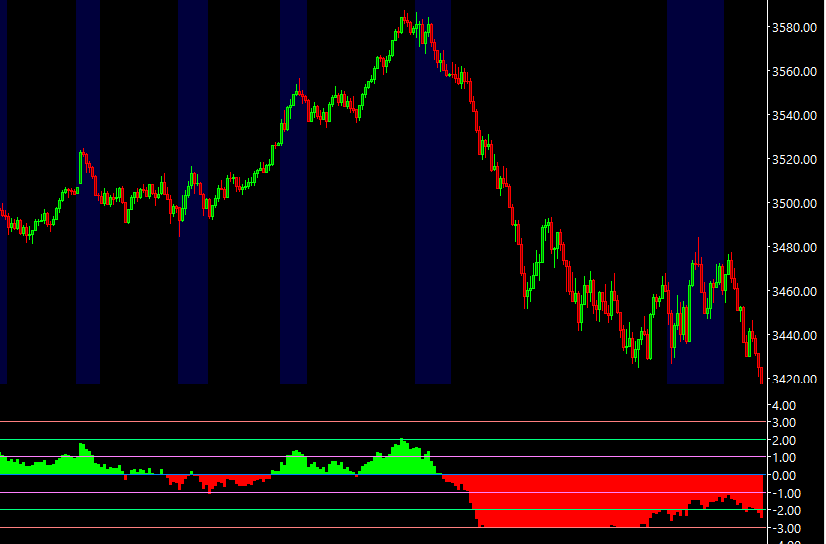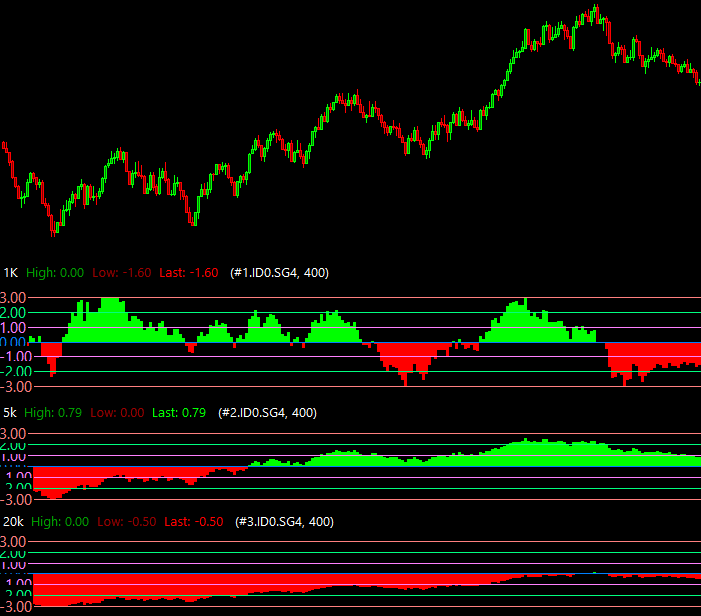Below is the transcript of the video you’ll get access to with your subscription.
Hello folks, this is Ralph. And today I’m going to show you how to use the linear regression study. If you haven’t already done. So please go ahead and watch the set up video so that you can get set up with the trip that you’re looking at right now today, I’m going to show you a very simple setup that you can trade in that I found to be pretty profitable over time.
And what I’ve done here is that I’ve seen set up two other charts for two others timeframes. So as you can see down here, we have the thousand trade chart, which is the one that we’re looking at right now. I have a 5,000 trade chart and a 20,000 trade chart. All using the linear regression, as you can see right here.
And the linear regression for each is plotting for the data on that chart. But what we’re going to do is we’re actually going to plot the data for each linear regression, all in one chart. So if we go to our 5,000 trade chart, you can imagine this chart being your main chart that you look at every day.
And it’s also the chart that you’d like to place trades on. So you want to see the data from the two other timeframes on this chart. So, what we’re going to do is we’re simply going to add the linear regression sub graph onto this chart from the two other timeframes. All right. So let’s go ahead and do that now.
So if you go to charts, study settings, I’m actually going to delete the current linear regression that we have. And then I’m going to add it three more times.
I did this just so that we can start with a clean slate. All right. So now we can point each one of them to the right data. So starting with the first one, we’re going to name this one, 1K. And it’s going to point to the data of the 1000 trade chart.
The second one is going to point to this chart and we’re going to name it. 5k.
And lastly, we’re going to point this one to the 20,000 trade chart.
Perfect. Now, if I hit apply, we should see those three subgraphs being added and they should look differently because they’re three different timeframes. Let’s go ahead and do that. I’m just going to make these smaller. So that we can see price a little bit better. All right. So now let’s talk about the setup.
What I like to look for is when the three different timeframes have the linear regression being plotted above the second standard deviation, either positively or negatively, that’s essentially the first requirement. And then the second requirement is going to be that the shortest timeframe. Whatever you use, you may choose to use 2000 trades, but I liked to look at the 1000 trade charts.
So for example, required, the thousand trade chart is pegged at the third standard deviation. So what does this actually look like? And we actually have an example right here on our screen, which is right here. So again, if we go so over the two conditions that we talked about first, we need. All three timeframes to be above the second standard deviation, either positively or negatively and right through this area, that condition is met.
In fact, it’s met a few other times it’s met right here. Actually, that’s not right. The highest timeframe does not meet that criteria. But if we look at this area over here, we can see that the 20,000 trade chart is above the second standard deviation to the negative side. But I think the best setup is obviously right here, right through this area.
And I’m going assume men a little bit so that you can see it much better.
But if we look at this area over here, you can see that all three are at their second standard deviation. So this is the right setup that you want to be taking. You want to wait for the shortest timeframe to peel off the third standard deviation. And that’s when you want to take the trade. Depends on how early you want to take the trade. It means that you’re going to get a better risk reward ratio, but also it’s well that it comes back to the third standard deviation. If that makes sense. For example, in this green candle right here, if we look at the data here, This probably peeled off at some point in time, which would have allowed you, if you’re a little bit more aggressive with your trading to take the trade, to get in long, but then as you can see, it wouldn’t have worked out and you would have likely gotten stopped, but then you would have had the opportunity to try again.
And that would have paid really nicely. So that’s essentially the trade. It’s pretty straightforward. There’s not much to it. Let’s see if we can find a few other cases where this occurs. This area right here is pretty close. But the middle timeframe, the 5,000 trade chart is not above the second standard deviation which is right through this horizontal line. So unfortunately this wouldn’t be a valid set up for this strategy. If we look at this area down here, it looks like it would have been just about the second standard deviation on the 5,000 great chart. So this is a trade that I would have taken, unfortunately, it’s right in the middle of the night so I probably was sleeping. Let’s see if we can find a short, as we just looked at a few longs,
this one’s almost a good setup, but the longest timeframe is not quite at the second center deviation. It’s almost there. And depending on how aggressive you are, you can take those trades. If you want. You just know that you’re running at more risk.
This one’s also just about they’re on the 5,000 trade chart. It’s debatable. If this would have been a good trade right through this area for short, it would have definitely worked out for a good amount of points. I’d say five to seven points or so it looks like we have a good one right through here.
And I apologize for these drawings right through here. They’re not really necessary for this video at all, but if we look at this area right through here, all three different timeframes were above their second standard deviation. You just wait for the shortest timeframe to peel off the third standard deviation and you take your short and maybe you get in around this area, you know, that your stop is at that high.
You know your risk and, you know, you can hold it for as long as you want up to 43 points in reward. So, or the last month of data that we just looked at, we found three to four different setups for this particular strategy that worked out just about every time. And this is why I want to share this very simple strategy with you because it works so often.
So I hope that you found this video useful and can incorporate it into your training until next time everyone, happy trading!



